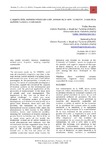L'impatto della mobilità territoriale delle persone sulle aree turistiche: il caso della mobilità turistico-residenziale

View/
Use this link to cite
http://hdl.handle.net/2183/22003
Except where otherwise noted, this item's license is described as Atribución-CompartirIgual 3.0 España
Collections
Metadata
Show full item recordTitle
L'impatto della mobilità territoriale delle persone sulle aree turistiche: il caso della mobilità turistico-residenzialeAlternative Title(s)
El impacto de la movilidad geográfica de las personas en las zonas turísticas : el caso del turismo y la movilidad residencialDate
2015Citation
ROTUR, 2015, 10: 23-42. ISSN: 1888-6884
Abstract
[Resumen] Las estimaciones de la OMT, hasta ahora
respetado todos esencialmente, dicen que en
la próxima década la movilidad turística y el
alcance global excederá la suma de un mil
quinientos millones de pasajeros. En esta
perspectiva, se destaca como prioridad la
cuestión del desarrollo sostenible del
turismo, a saber, el control de los impactos
de la movilidad del turismo sobre el medio
ambiente y la sociedad, y la aplicación
práctica de los principios de la sostenibilidad
de la vida cotidiana de las personas y la
gestión del suelo. La impresión es que usted
está frente a un "desafío global", a la que
debe responder por los modelos de
reclutamiento de un desarrollo equilibrado y
compartido, no sólo a nivel local a nivel
global. Sin embargo, este problema si hay
otra: las estimaciones no incluyen la
movilidad turística internacional totalmente,
ya que el fenómeno es poco conocido a la
estadística oficial, turístico y movilidad residencial, es decir, el movimiento de
turistas que se hospedan en casas
particulares a el uso de vacaciones. Sin
embargo, en Italia, como en muchas otras
partes del mundo, el turismo residencial (o
de viviendas particulares es un fenómeno
social muy relevante, que la masa turismo
organizado convencional tiene en común sólo
las raíces. Este papel, utilizando una parte
de las innumerables actividades de
investigación llevadas a cabo en los últimos
diez años en la movilidad residencial turístico
del Centro de Investigación y Estudios en
Turismo de la Universidad de Calabria,
quiere hacer hincapié en los efectos positivos
y negativos de esta tipo de movilidad
turística, en una situación de gran
envergadura del fenómeno, y en una zona
italiana entre los menos desarrollados en el
país [Abstract] The estimates made by the UNWTO, until
now all essentially respected, say that in the
next decade tourist mobility and global reach
will exceed the sum of one and a half billion
passengers. In this perspective, it stands as a
priority the issue of sustainable development
of tourism, namely the control of the impacts
of tourism mobility on the environment and
society, and the practical application of the
principles of sustainability to the daily lives
of people and land management. The
impression is that you are in front of a
"global challenge", to which you must
respond by recruiting models of balanced
development and shared not only locally on a
global level. However, there isn’t only this
problem: the estimates do not include
international tourist mobility fully, since the
phenomenon is little known to the official
statistics, tourist and residential mobility,
meaning the movement of tourists staying in
private homes to holiday use. Yet in Italy, as
in many other parts of the world, the
residential tourism (or of private homes is a
social phenomenon very relevant, that the
conventional tourism organized mass has in
common only the roots. This paper, using a
part of the countless research activities
carried out in the last ten years on the
mobility residential tourist from Centre for
Research and Studies on Tourism of the
University of Calabria, wants to emphasize
the positive and negative impacts of this type
of tourist mobility, in a situation of great
spread of the phenomenon, and in an Italian
area among the least developed in the
country.
Keywords
Movilidad
Turismo
Residencial
Segunda casa
Impactos
Capacidad de carga
Sustentable
Mobility
Tourism
Residential
Second-home
Impacts
Carrying capacity
Sustainable
Turismo
Residencial
Segunda casa
Impactos
Capacidad de carga
Sustentable
Mobility
Tourism
Residential
Second-home
Impacts
Carrying capacity
Sustainable
Rights
Atribución-CompartirIgual 3.0 España
ISSN
1888-6884






